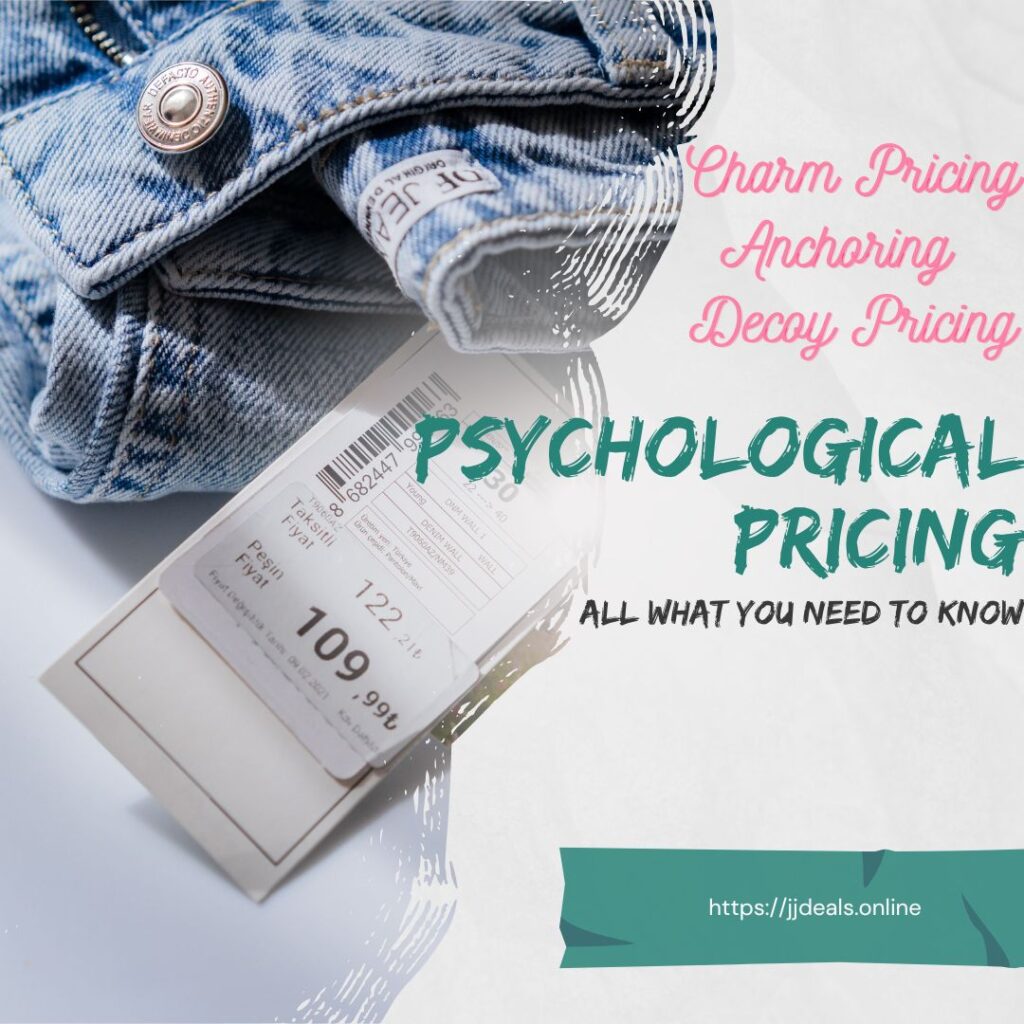
Psychological Pricing
Pricing Psychology – All what You Need To Know.
Psychological Pricing
Examining the Impact of Pricing on Consumer Behavior.
Pricing is a critical aspect of marketing strategy, and businesses often employ various techniques to influence consumer behavior and maximize sales. One intriguing approach is psychological pricing, which taps into the subconscious mind of consumers to shape their perception of value and influence their purchasing decisions. In this blog, we will explore the fascinating world of psychological pricing, delve into the concepts of charm pricing, anchoring, and decoy pricing, and analyze their impact on consumer behavior.
Understanding Psychological Pricing
Psychological pricing is a marketing strategy that recognizes the influence of human psychology and cognitive biases on consumer behavior. It revolves around the idea that consumers’ perception of a product’s value can be manipulated through strategic pricing techniques. By tapping into these psychological factors, businesses can create an illusion of value or affordability, thus influencing consumers’ decision-making processes.
The success of psychological pricing lies in its ability to exploit certain cognitive biases that are inherent in human nature. These biases affect how consumers perceive and process pricing information, often leading to predictable patterns of behavior. By understanding and utilizing these biases, businesses can shape consumers’ perceptions and increase the likelihood of making a sale.
One common technique employed in psychological pricing is charm pricing, which involves setting a price that ends in the number nine (e.g., $9.99 instead of $10). This pricing strategy takes advantage of the left-digit effect, where consumers tend to focus on the first digit and perceive a significant difference between, for example, $9.99 and $10. This subtle difference can create the perception of a lower price, even though the actual difference is minimal. By employing charm pricing, businesses can make their products appear more affordable and appealing to consumers.
Anchoring is another influential psychological pricing strategy. It capitalizes on the cognitive bias known as anchoring and adjustment, where individuals rely heavily on the first piece of information they receive when making judgments or decisions. In the context of pricing, businesses set a high-priced item as a reference point or anchor. This anchor serves as a mental benchmark against which consumers evaluate subsequent prices. As a result, the subsequent prices may appear more reasonable or affordable in comparison. Anchoring can be effective in influencing consumers to choose higher-priced options that are positioned relative to the anchor, as those options now seem more favorable by comparison.
Decoy pricing is yet another technique used in psychological pricing. It involves introducing a third option, or a decoy, alongside two existing products. The decoy is strategically priced to make one of the original products appear more attractive in terms of value or features. By presenting consumers with a seemingly better deal or a compromised option, businesses can nudge consumers toward their desired choice. Decoy pricing takes advantage of the contrast effect, where consumers’ preferences are influenced by the relative differences between options rather than evaluating each option on its own merits.
Psychological pricing strategies are effective because they align with how the human mind processes information and makes decisions. By understanding and leveraging these cognitive biases, businesses can influence consumers’ perceptions of value, affordability, and the overall desirability of their products or services. However, it is important to note that ethical considerations should always be taken into account when implementing psychological pricing techniques, as transparency and honesty are crucial in maintaining consumer trust.
Lets delve into psychological pricing strategies in detail
Pricing Psychology – Charm Pricing

Charm pricing is a popular and widely used psychological pricing strategy that involves setting a price that ends in the number nine, such as $9.99 instead of $10. This pricing technique capitalizes on the left-digit effect, which refers to the tendency of consumers to focus on the first digit of a price and perceive it as significantly lower than it actually is. Despite being a simple and subtle adjustment, charm pricing has been proven to have a profound impact on consumer behavior.
The psychological reasoning behind charm pricing lies in the way our brains process numerical information. Our minds are wired to process information quickly, and we often rely on mental shortcuts to simplify our decision-making process. When confronted with a price, we tend to focus on the leftmost digit, which holds greater cognitive weight compared to the digits that follow. This is known as the most significant digit or the left-digit effect.
By setting a price just below a whole number, such as $9.99 instead of $10, businesses create an illusion of significant savings in the minds of consumers. The difference of just one cent between $9.99 and $10 might seem trivial, but our perception is heavily influenced by the presence of the number nine as the leftmost digit. It creates a subconscious association with lower prices, value, and affordability.
Charm pricing leverages several psychological factors to influence consumer behavior. Firstly, it creates a perception of a bargain or discount. Consumers tend to interpret a price that ends in .99 as being closer to the lower whole number. In the case of $9.99, consumers are more likely to perceive it as being closer to $9 than $10. This perception triggers a positive emotional response, making the price more appealing and encouraging purchase.
Secondly, charm pricing exploits the concept of precision. Research suggests that consumers associate precise prices, such as those ending in .99, with higher value and quality. This association is attributed to the belief that precise prices indicate a well-considered and carefully calculated value proposition. As a result, charm pricing can enhance consumers’ perceptions of the product’s quality, even if the actual quality remains unchanged.
Furthermore, charm pricing can increase the perceived affordability of a product. When a price is slightly lower due to charm pricing, it may appear more accessible to consumers, particularly those who are price-sensitive or seeking a good deal. This can attract a larger customer base and drive sales volume.
The effectiveness of charm pricing in increasing sales has been extensively studied and validated. Numerous experiments and real-world observations have consistently shown that charm pricing leads to higher sales compared to rounded prices. This pricing strategy has been widely employed in various industries, including retail, e-commerce, and hospitality, to stimulate purchases and maximize revenue.
However, it is important to note that charm pricing is not universally effective in all situations. Its effectiveness can vary depending on the product, target audience, and market context. Factors such as perceived value, competition, and the price sensitivity of the target market should be carefully considered when implementing charm pricing.
In conclusion, charm pricing takes advantage of the left-digit effect and our cognitive biases to create an illusion of value and affordability in consumers’ minds. By setting prices that end in .99, businesses can trigger a perception of savings and bargains, increase the perceived quality of their products, and enhance their overall appeal. While charm pricing is a widely adopted strategy with proven effectiveness in increasing sales, it should be implemented strategically, considering the specific market dynamics and consumer preferences.
Pricing Psychology – Anchoring
Anchoring is a powerful pricing technique that takes advantage of consumers’ tendency to rely heavily on the first piece of information they receive when making judgments or decisions. By strategically setting a high-priced item as a reference point or anchor, businesses can influence consumers’ perception of subsequent prices, making them seem more reasonable or affordable. Anchoring taps into cognitive biases and the way our brains process information, ultimately impacting consumer decision-making.
The theory behind anchoring is rooted in the concept of the primacy effect, which suggests that information encountered early on has a stronger influence on our judgments than information received later. When consumers encounter a price anchor, it sets a mental benchmark against which subsequent prices are evaluated. As a result, the anchor exerts a disproportionate influence on the decision-making process, shaping consumers’ perception of what is a fair or acceptable price.
Anchoring can take various forms in pricing strategies. One common approach is to introduce a high-priced item before presenting other options. For example, a retailer might display a premium product with a higher price tag prominently before showcasing other products at comparatively lower prices. By exposing consumers to the high-priced anchor first, subsequent prices appear more reasonable in comparison. The presence of the anchor creates a frame of reference that influences consumers’ judgments of value and shifts their willingness to pay.
Real-world examples of anchoring can be found in various industries. In the hospitality sector, hotels often present a deluxe suite or an expensive room option as the first choice when displaying their offerings. This serves as an anchor that makes the subsequent room rates appear more affordable to potential guests. Similarly, in the automotive industry, car dealerships might showcase high-end luxury models to anchor consumers’ expectations before introducing more moderately priced vehicles, making them seem like better deals.
Anchoring can also be employed through pricing strategies such as “price bundling.” In this approach, businesses offer a package or a bundle that includes several products or services together at a higher overall price. By setting a high anchor price for the bundle, the individual prices of the bundled items may appear lower when compared to the total price of the package. This makes the bundle seem like a more attractive option, even if the individual items are not discounted significantly.
The impact of anchoring on consumer decision-making is significant. Studies have consistently shown that consumers are influenced by the initial anchor when evaluating subsequent prices. The anchor establishes a reference point that shapes consumers’ perceptions of value and fairness. As a result, consumers tend to make judgments relative to the anchor, rather than evaluating each price independently. This bias can lead to higher acceptance of prices that might have initially seemed too high, as long as they are presented in contrast to a higher anchor.
However, it is important to note that anchoring is not a foolproof strategy and its effectiveness can be influenced by various factors. The relevance and credibility of the anchor, the context in which it is presented, and the individual characteristics of consumers all play a role in how anchoring influences decision-making. Different consumers may anchor differently based on their prior knowledge, experiences, and preferences.
In conclusion, anchoring is a powerful pricing technique that leverages consumers’ reliance on the first piece of information they receive. By strategically setting a high-priced anchor, businesses can shape consumers’ perception of subsequent prices, making them seem more reasonable or affordable. Anchoring influences decision-making by establishing a reference point and framing consumers’ judgments of value and fairness. By understanding the cognitive biases associated with anchoring, businesses can optimize their pricing strategies to drive sales and maximize revenue.
Pricing Psychology – Decoy Pricing
Decoy pricing is a pricing strategy that involves introducing a third option, known as the “decoy,” alongside two existing products, with the intention of influencing consumers’ preferences towards a specific product. The decoy is strategically priced to make one of the original products appear more attractive in terms of value or features. Decoy pricing takes advantage of cognitive biases and decision-making heuristics to sway consumer choices.
The underlying principle behind decoy pricing is the concept of relative comparison. When presented with multiple options, consumers tend to evaluate and make decisions based on the relative differences between those options, rather than assessing each option on its own merits. By introducing a decoy, businesses can manipulate the perceived value and desirability of the original products.
The decoy is intentionally designed to be less appealing than the target product in terms of value or features, despite being priced similarly or higher. This creates a contrast effect that makes the target product seem more attractive by comparison. Consumers are more likely to perceive the target product as a better deal or a superior choice when it is positioned relative to the decoy.
Notable case studies and experiments have highlighted the effectiveness of decoy pricing. One classic example involves The Economist magazine. In a study conducted by behavioral economist Dan Ariely, participants were given two subscription options: an online-only subscription for $59 and a print-only subscription for $125. In this scenario, most participants chose the online-only option. However, when a third decoy option was introduced – an online and print subscription for $125, identical to the print-only subscription – the preference shifted dramatically. The majority of participants now chose the print-only subscription for $125, considering it a better value compared to the seemingly overpriced combined option. The decoy played a crucial role in influencing consumer choices by making the print-only subscription appear more attractive.
Decoy pricing can be found in various industries. In the food and beverage industry, fast-food chains often use decoy pricing to drive sales of certain menu items. For example, a combo meal that includes a burger, fries, and a drink may be priced slightly higher than a standalone burger and fries. By introducing the combo meal as a decoy, the standalone burger and fries become more appealing, even though their prices remain the same. The decoy creates a perception of added value and encourages customers to choose the standalone items.
Decoy pricing is effective because it leverages consumers’ reliance on relative comparisons and their tendency to seek the best perceived value among available options. The contrast created by the decoy influences consumers’ perception of value and skews their preferences towards the target product. This pricing strategy can not only increase sales of the target product but also enhance overall revenue by encouraging consumers to opt for higher-priced options that are positioned favorably relative to the decoy.
However, it is important for businesses to consider ethical considerations when employing decoy pricing. Transparency and fairness are crucial in maintaining consumer trust. If the decoy pricing strategy is perceived as manipulative or misleading, it can have negative consequences for a company’s reputation and long-term customer relationships.
In conclusion, decoy pricing is a powerful strategy that influences consumer preferences by introducing a less appealing option, the decoy, alongside existing products. By strategically pricing the decoy, businesses can enhance the perceived value of the target product and steer consumer choices. Decoy pricing takes advantage of cognitive biases related to relative comparison and can be a valuable tool in driving sales and optimizing pricing strategies when implemented ethically and transparently.
The Power of Perceived Value

Psychological pricing strategies are rooted in the concept of perceived value—the subjective assessment consumers make about the worth or desirability of a product or service. Perceived value plays a crucial role in consumer decision-making processes, as it heavily influences purchase intentions, willingness to pay, and overall customer satisfaction. By understanding the psychological factors that contribute to perceived value, businesses can optimize their pricing strategies and enhance consumer engagement.
Quality
Consumers associate higher prices with higher quality. The perception of quality is often influenced by factors such as durability, craftsmanship, brand reputation, and perceived benefits. Strategic pricing can shape consumers’ perception of quality by aligning prices with the desired positioning of the product. Setting a higher price can signal exclusivity, superior craftsmanship, or advanced features, which can enhance the perceived value of the product.
Scarcity
The scarcity principle suggests that people value things that are limited in availability. By creating a sense of scarcity around a product, businesses can increase its perceived value. Limited editions, time-limited offers, or limited stock can drive consumer interest and create a perception of exclusivity and higher value. Scarcity can be emphasized through pricing strategies, such as offering discounts for a limited time or creating a tiered pricing structure that increases with demand.
Social Proof
Consumers often look to others for guidance in decision-making. Social proof is the psychological phenomenon where individuals assume the actions or choices of others in uncertain situations. Businesses can leverage social proof to enhance perceived value by highlighting positive reviews, testimonials, or endorsements. When consumers see that others have found value in a product, it increases their perception of its worth and can justify higher pricing.
Branding
Branding plays a significant role in shaping perceived value. Strong brands are associated with trust, reliability, and positive experiences. Consumers are often willing to pay a premium for products or services from well-established and reputable brands. Effective branding can differentiate a product from competitors and create an emotional connection with consumers, influencing their perceived value and willingness to pay.
Psychological pricing strategies interact with these factors to shape consumers’ perception of value. For example, charm pricing (setting a price just below a whole number, like $9.99) can create the perception of affordability and a good deal. Anchoring can influence perceived value by positioning prices relative to a high anchor, making them seem more reasonable. Decoy pricing can enhance perceived value by creating a contrast between options.
It is important to note that perceived value is subjective and can vary across individuals and market segments. Different consumers may have different priorities, preferences, and interpretations of value. Therefore, businesses should conduct market research, gather consumer insights, and segment their target audience to tailor their pricing strategies effectively.
By understanding the psychological factors that contribute to perceived value, businesses can optimize their pricing strategies to align with consumer expectations, preferences, and willingness to pay. A well-executed pricing strategy that enhances perceived value can not only drive sales but also foster customer satisfaction, loyalty, and positive brand associations.
In conclusion, perceived value is a critical factor in consumer decision-making processes. Psychological pricing strategies aim to influence consumers’ perception of value by considering factors such as quality, scarcity, social proof, and branding. By understanding how pricing interacts with these factors, businesses can optimize their marketing strategies, enhance consumer engagement, and ultimately drive business success.
Pricing Psychology – Ethical Considerations
While psychological pricing techniques can be effective in influencing consumer behavior, businesses must carefully consider the ethical implications associated with these strategies. Transparency, fairness, and maintaining consumer trust are crucial factors that businesses should prioritize when implementing psychological pricing techniques. It is important to strike a balance between maximizing profits and ensuring consumer satisfaction.
Transparency
Transparency is key in maintaining ethical practices when it comes to pricing strategies. Businesses should strive to be open and honest about their pricing practices, ensuring that consumers have a clear understanding of how prices are set and the reasoning behind them. Concealing or manipulating pricing information can lead to a breach of trust and harm the reputation of the business. Clear and transparent communication is essential to avoid misleading or deceiving consumers.
Avoiding Manipulation
While psychological pricing techniques aim to influence consumer behavior, it is essential to avoid manipulative tactics that exploit cognitive biases or create false perceptions. Businesses should refrain from intentionally misleading consumers by using deceptive pricing tactics. Consumers should feel empowered to make informed decisions rather than feeling coerced or tricked into making a purchase.
Fairness
Ethical pricing practices emphasize fairness to consumers. Businesses should ensure that their pricing strategies do not discriminate or take advantage of vulnerable individuals or groups. Discriminatory pricing based on factors such as race, gender, or socioeconomic status is unethical and should be strictly avoided. Fairness also involves offering consistent pricing across different channels and avoiding price discrimination based on consumer characteristics or purchase history.
Consumer Well-being
Ethical considerations should prioritize the well-being of consumers. Businesses should avoid practices that exploit consumers’ vulnerabilities or manipulate their emotions solely for the purpose of increasing sales. Pricing strategies should not exploit cognitive biases in ways that harm consumer welfare or lead to impulsive or uninformed purchases. Instead, businesses should focus on providing value and meeting genuine consumer needs.
Pricing Psychology – Long-term Relationships
Maintaining consumer trust and fostering long-term relationships should be a priority for businesses. While psychological pricing techniques can drive short-term sales, they should not come at the expense of long-term customer satisfaction and loyalty. Engaging in ethical pricing practices builds a positive reputation and fosters customer loyalty, resulting in repeat business and positive word-of-mouth recommendations.
Businesses can strike a balance between maximizing profits and maintaining ethical pricing practices by considering the following approaches:
- Conducting Consumer Research: Understanding consumer preferences, needs, and concerns is essential. Conducting market research and obtaining feedback from consumers can help businesses align their pricing strategies with consumer expectations and ethical considerations.
- Testing and Monitoring: Businesses should continuously evaluate the impact of pricing strategies on consumer behavior and ethical implications. Conducting tests, monitoring customer feedback, and adapting pricing practices accordingly can help ensure fairness and transparency.
- Educating Consumers: Businesses can proactively educate consumers about their pricing strategies and the value they offer. Clearly communicating pricing structures, discounts, and promotions can help consumers make informed decisions and reduce the potential for confusion or mistrust.
- Industry Standards and Regulations: Adhering to industry standards and regulations can provide guidance on ethical pricing practices. Businesses should familiarize themselves with relevant regulations and industry guidelines to ensure compliance and ethical behavior.
While psychological pricing techniques can be effective, businesses must approach them with a strong commitment to transparency, fairness, and consumer well-being. Striking a balance between maximizing profits and maintaining ethical practices requires careful consideration of the impact on consumers and their trust. By prioritizing transparency, fairness, and long-term relationships, businesses can use psychological pricing techniques ethically and responsibly, benefiting both consumers and the business itself.
Pricing Psychology – Conclusion
Psychological pricing is a fascinating field that highlights the intricate relationship between pricing, consumer behavior, and human psychology. By employing strategies like charm pricing, anchoring, and decoy pricing, businesses can tap into the subconscious mind of consumers and shape their purchasing decisions. However, it is crucial for businesses to consider ethical implications and maintain transparency to build long-term relationships with customers. Understanding the impact of psychological pricing can empower both businesses and consumers in navigating the complex world of pricing and consumer behavior.
Shifted Market Pricing Strategy – All You Need to Know




